Menus
- Monsieur’s superbike, almost, Toulemonde
- Work of art
- To infinity and beyond
- Conclusion
- Summary of HP4 series equipment
- HP4 with Competition pack
- Technology
- Data acquisition system and personal calibration tool (option: € 600 and € 1,100)
- Dynamic Traction Control (DTC)
- Dynamic Suspension Management (DDC – Dynamic Damper Control)
Monsieur’s superbike, almost, Toulemonde
26,000. This is the number of copies of the BMW S 1000 RR sold around the world in … 3 years! Even the Bavarian firm did not expect such success. With an efficiency little challenged by the competition and already improved in its 2012 vintage, the sportswoman from Munich now offers a HP series for High Performance… Thus prepared, the beautiful four-cylinder joins the previous bodybuilding machines, with a flat twin engine, HP2 Enduro, HP2 Megamoto and HP2 Sport already offered by the German brand in 2005, 2007 and 2008. On the menu? Extreme, of course. Engine response further refined, less weight but above all an electronic offer opening the doors to high competition. And a style that invests more and more in the aesthetic codes of the track, for a devastating seduction.
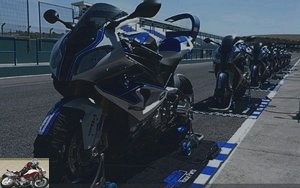
Work of art
For the test of such a "rocket", welcome to the circuit of Jerez, Spain, one of the temples of motorcycle GP. The day promises to be hot, and not only in the weather … Our mount for the day develops 193 combat hp (often more in real life) trained for the win and placed under the control of chips exploiting every drop of their energy. A whimsical crew for a behavior that is no less. BMW also offers a presentation that meets the brand’s standards: 25 machines are waiting, neatly arranged, on their respective dedicated mats, the tires warm under their cover..
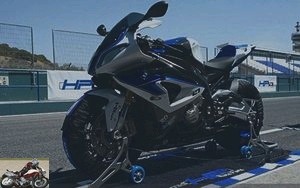
In its high performance livery, the BMW S1000RR already “steals” the retinas. Exuding sport in every shape, its fighter plane plastic and top model finishes make it highly desirable. We admire the paint specific to the brand’s colors and the multiple HP4 signatures. This specific dress, all in contrast, energizes on its own a physical yet very aggressive as standard. However, compared to the latter, the differences are so numerous that they almost relegate it to the rank of basic. (see the summary of equipment at the end of the test). Let us remember in particular a finer Race ABS, the presence of continuously controlled suspensions (DDC – Dynamic Damping Control) and the precision adjustment of the traction control in "Slick" mode on 14 levels. The weight is reduced by nearly 10 kg, with 199 kg in running order, thanks, among other things, to the adoption of a complete line in titanium (- 4.5 kg) and black anodized, forged light alloy wheels. (-2.5 kg). This last point decreases as much the unsprung masses, thus optimizing acceleration, deceleration and above all maneuverability.
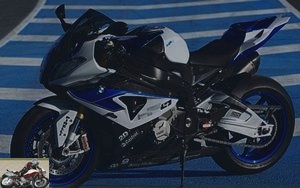
Isn’t that enough for you? What then to say about this mechanical sculpture that the Competition pack sublime yet? Thus, endowed with carbon composes many elements of the fairing. The brake and clutch levers are then foldable and the rider’s footrests can be adjusted. The rims sport a metallic blue tint. What could he possibly be lacking? Let’s be petty: for the possible passenger of your high-speed ship, plan an option; The beauty is in fact designed from the outset for single-seater use.
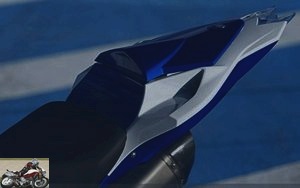
In good Germanic, and although pure pistarde, the S 1000 RR nevertheless retains a certain comfort. The saddle welcomes the pilot nicely. But sitting is not the main argument of this machine. Ultra compact, the Munich girl offers just enough space for my size. My meter eighty-four takes a few moments to find its place, ergonomics being dictated by and for efficiency. The flexion of the legs is marked and the torso tilted towards the cockpit. Ideal position to admire the laser-engraved upper triple tree bearing the serial number.
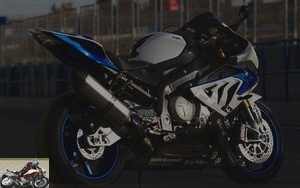
Before the siren sounds announcing the first practice session, let’s take a look at the dashboard and controls. Particularly ergonomic in view of the multiple functions available, these differ little from those of the "entry-level" S 1000 RR. On the right grip, the Mode button selects one of the four settings (Rain Sport, Race, Slick) controlling in a predetermined way engine mapping, electronic suspension settings and DTC (Dynamic Traction Control) implementation levels. The latter fixed on "Slick" will then be adjustable by a new left-side push-button. Seven positive and negative values plus a neutral then regulate the intrusion of the system into your steering, allowing more or less rear wheel drifts. Each increment corresponds to 0.5% of modulation, at zero an intervention comparable to the system fitted to the motorcycle as standard. Adjoining this novelty, there is also the button managing the start of the stopwatch, the odometer and the partial ones as well as the adjustment of the DDC suspensions. Race ABS and traction control can, for the more playful, be deactivated by a dedicated control. Note the excellent craftsmanship of these optional levers, with micrometric adjustments, adapting as finely as possible to the morphology of the pilot.
The instrument block remains as clear and readable as ever. The analog tachometer dial is enhanced with the HP4 logo. It uses the Best Lap in Progress function, informing the pilot, on the circuit, of the improvement or not of his best lap recorded on the track, and this every 100 meters…
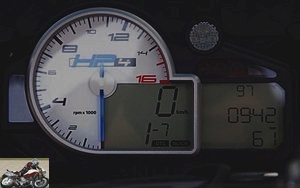
More specifically, the Lauch Control and speed limit functions respectively allow a start with assistance limiting wheeling and circulation at a predetermined pace in the pits … The race spirit in every detail. And again, this is only the visible part of what this true Superbike can offer. Monster of technology, "hardware" but also "software" are fully configurable. (see Racing calibration options)
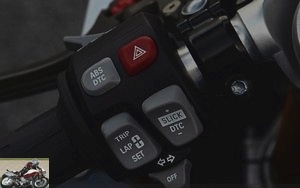
Finally, the German, later wearing Slick tires, is currently launching the new Pirelli twin-compound Diablo Supercorsa SP, in 120/70 ZR17 and 200/55 ZR17. These make up the standard fitment, now incorporating 23% more soft rubber on their shoulders and 24% additional surface devoid of grooves. Their carcass is also more rigid.
To infinity and beyond
In order to best assess the settings offered, I go in Sport mode, corresponding to road use. Surprisingly, the S 1000 RR HP4 was less rigorous under braking and on the angle than its sister with more conventional suspensions. The machine floats more when biting through the one-piece Brembo calipers. Shock absorber and forks controlled by the DDC (optional control for the front) offer, in fact, maximum comfort.
Suitable for driving on public roads, this mode will delight happy owners wishing to drive on a daily basis. The slightest road fault is instantly filtered out, with compression and rebound damping taking place in real time !
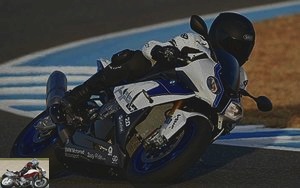
We can also clearly feel the changes made to the engine profile. Thus, the torque delivered between 6,000 and 9,750 rpm is increased. Even more available, the four-cylinder in-line now gives its full power with an identical gas intake law and, therefore, an appropriate response in all four driving modes, even in "Rain"! However, for this one, the power and torque curves were all the same smoothed out in the speed range between 2,500 rpm and 8,000 rpm … Phew !
Let’s move on to Race mode. The German missile regains its superb appearance and "crashes" like few other machines. More incisive, specifies the HP4 then jostles its pilot with its almost violent acceleration. To be convinced of this, just see the almost continuous illumination of the DCT power-on indicator. Giving pride of place to large, fast curves, generating significant downforce, the layout of the Spanish circuit undermines the hyper-sport envelopes when the 193 nags of the Bavarian block break. You might as well finish these gums with the "Slick" program
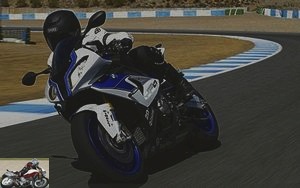
So configured for the best of its engine and chassis capacities, the S 1000 RR HP4 is always more lively and rigid. Impressive, the Munich block can now express its muscular ardor that its sharp geometry exalts. Full as a barrel of beer from the other side of the Rhine that would have been shaken for hours, the four-cylinder pushes at all speeds. Its verve is effectively backed up by a fast gearbox, fitted with a standard shifter. Its implementation punctuates each gear change with an audible exhaust slam.
However, beware of reckless go-arounds. The electronics, once constrained to your choice in this competition mode, could well be lacking. DTC and anti-wheeling are now inactive when the machine takes more than 30 ° of angle. Thus, my imperfect piloting gave the track an unexpected comma. In addition, a temperature of over 32 ° C during the test did not help to spare me this heat, the original tires degrading more quickly under stress. Receiving the Prussian cavalry with dignity, the Supercorsa SP show good stability on the angle and transmit information efficiently. They will only show their limits to the most experienced.
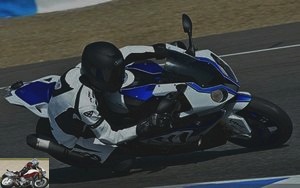
Despite everything, galvanized by the indicator of the best lap in progress, we still take the machine faster and faster at the start of a curve. This throws itself naturally in bends but easily allows course corrections. A real rail on the corner while leaving control and handling flexibility on board, even when entering on the brakes. These, extremely powerful, benefiting from specific pads, nevertheless allow excellent control. Their quality had already "stuck" me on the basic S1000RR 2012 version.
The Motorrad Race ABS (partially integral) offers on this "Slick" setting an optimization of the forces transmitted to the calipers. It reveals as much strength and endurance as it is easy to dose. The rear caliper, controlled at the same time from the front, helps to seat the set. Intrusive in "Sport", the anti-lock is much more discreet in the other modes. In the latter, the rear wheel load-bearing detection function as well as its ABS are deactivated, so that an experienced rider can steer the HP4 using the rear brake and perform controlled slips. Grasping the lever at the angle to optimize a trajectory does not cause any side reactions. In addition, with a limited-slip clutch, gears are stacked at the end of the straight line without further ado.
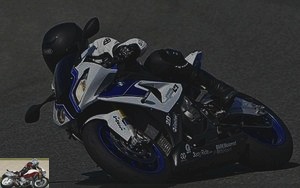
A break is welcome to equip our intersiderant mount with tires, still Italian, with the predestined name Diablo Superbike, really adapted to the day’s driving. Needless to say, these racing compounds will highlight the qualities and possible shortcomings of high performance hyper-sport..
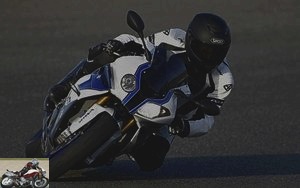
In fact, the S 1000 RR HP4 becomes more physical. Put on these Slick envelopes, all the dynamics of the Bavarian HP4 are multiplied tenfold. A real lightning-fast orbiting / deceleration machine, the machine could reveal your presence as the only weak link in the crew. Each go-around, finely managed by the Ride by Wire, wedges you badly towards the seat cowl. The curves flow to your visor as the one-piece, four-piston radial calipers grapple with the rotors, modulate your pace and then let the German plane fly like a bullet again. The propeller of its logo is really not spoofed. Same observation for the soundtrack.
The metallic symphony of its ultra-light exhaust line with controlled acoustic shutter vehemently accompanies your laps with almost too much force. Radical, extreme, the HP4 seemed lost in the Superbike championship. In fact, co-developed with pilot Toy Corser, this BMW once again sets the general performance bar very high. The new DDC suspensions are thus adjustable on the handlebars (when stationary), via the associated menu. I have not tried the experience of modifying these data, which are fully successful for my level of driving on such a high-performance machine. Be aware, however, that the adjustment possibilities on the track are simply astounding. (see technology section).
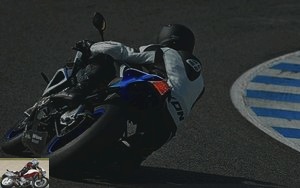
In terms of the imperfections noted, we still deplore a certain liveliness in the action of electronics, in particular DTC. More sporadically, false dead points or a few rare latencies between two reports may have arisen. The multitude of information managed by the processor can, perhaps, partly explain these approximations. Points to be confirmed.
Finally, unfolding the crutch hidden by the optional long carbon shoe takes a little getting used to.
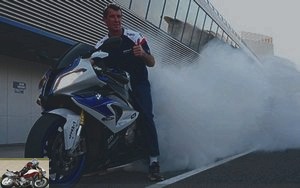
Conclusion
A racing machine in the truest sense of the word, the S 1000 RR HP4 offers the best of BMW technology, delivered in a case of the same caliber. As elegant as it is racy, even more powerful and technological, German hyper-sport is radicalizing its positions. It also gives a big slap on the upper fringe of the segment, just to seal any attempt to challenge its almost hegemonic position. With its victories in the Superbike championship, and a 3rd place at the 24 hours of Le Mans, behind seasoned teams, the HP4 enjoys a more positive image than ever.
This high performance version, packed with assistance, is aimed at those whose talent and / or bank account are at the level of the Bavarian’s performance. Likewise, the data acquisition options (€ 600) and the Course calibration tool (€ 1,100) will appeal to teams or individuals engaged in competition. (see Racing calibration options)
No price is officially announced but rumors give a range of 20,000 to 24,000 €. As a reminder, the "simple" S 1000 RR is offered at € 16,500 access price. It takes € 18,710 with ABS-Race, DTC and shifter, almost inevitable options, the German playing, as often the rest of the family, in the high regimes of bank accounts. In view of the on-board innovations, we can bet that the HP4 will ask, at a minimum, € 4,000 more than this last value and € 2,000 more for the Competition pack. A note over € 25,000? Response to the Cologne fair.
However, the “normal” version of this year 2012 does not demerit in any way. While the real-time controlled suspension system can significantly improve handling on the road, it is difficult to measure its effectiveness on the track. On the other hand, more electronic, the HP4 version may turn off those for whom motorcycles do not rhyme with computers. It would indeed be in bad taste to see such an achievement start in "safe" mode..
A dream machine, a precision tool as much as a showcase of BMW know-how, the S 1000 RR HP4 is an aesthetic and dynamic success. Although not accessible to all, this wonder will highlight the less prestigious version all the more. It will also further elevate the image of high performance now conveyed by the brand to the propeller.
Strong points
- Gargantuan motorization
- Cycle part
- Finishes
- Powerful braking
- General ergonomics
- Electronics (Race ABS, DTC, DDC),
- data acquisition and configuration (optional)
Weak points
- Assumed price of the machine and the packs
- Still unpleasant DTC implementation
Price ??? €
Competitors: Aprilia RSV4, Ducati 1198S, Honda CBR 1000 RR, Kawasaki ZX-10R, Suzuki GSXR 1000, Triumph Daytona, Yamaha R1.
Datasheet
All BMW tests
Summary of HP4 series equipment
- Engraving of the HP4 logo and serial number on the triple clamp.
- Lightest four-cylinder hypersport car in the 1000cc class³ : 199 kilograms (empty weight according to DIN, tank 90% full).
- Innovative cycle part with DDC Dynamic Damping Control (Dynamic Damping Control).
- Race ABS with IDM calibration.
- Dynamic Traction Control DTC (Dynamic Traction Control) with fine tuning in "Slick" mode.
- Automated start function (Launch Control).
- Appropriate wheelie detection.
- New rear tire size 200/55 ZR 17.
- Standard shifter.
- Lightweight titanium exhaust line with controlled acoustic shutter and interference tube.
- Forged light alloy wheels, black anodized.
- Brembo radial monobloc brake calipers with special pads.
- Floating brake discs with nine front mounting sleeves.
- Extended and split engine spoiler.
- Saddle with a single-seater look thanks to the passenger seat cowl.
- LED turn signals.
- Tinted windshield.
- Lightweight 7 Ah battery.
- High performance motor tuning.
- Increased torque in the mid-rev range.
HP4 with Competition pack
- Long closed carbon engine guard.
- Sponsor sticker kit supplied with the pack.
- Racing blue metallic wheels.
- HP Carbon insert holder.
- HP Carbon tank protection.
- HP folding brake lever.
- HP folding clutch lever.
- Adjustable HP rider footrests.
Technology
Data acquisition system and personal calibration tool (option: € 600 and € 1,100)
The first gives you information at the end of your circuit sessions. Each parameter (acceleration, deceleration, angle …) is displayed in the form of curves and according to the key points of the circuit, previously defined. Indeed, each circuit can be "learned" by the HP4 !
The second makes you and your S 1000 RR HP4 a complete racing team … as long as you have the knowledge of a specialist engineer. Otherwise, you will have to hire. Thus, this program allows you to modify your mount in the smallest details.
Injection and ignition are thus adjusted according to the 4 available modes and for each gear or the angle of rotation of the throttle grip.
Regarding the DTC, the level of grip is modulated according to the engine speed, from 2 to 12,000 revolutions, the angle of the motorcycle … likewise the incrementation of the setting in Slick mode can change in percentage on each variable . Same possibility for Race ABS.
DDC damping can also best adapt to the development of the track chosen … Once the track is memorized, the suspensions work optimally on the track.
You will finally adjust the response of the shifter and the limits of the start-up assistance (Launch Control).
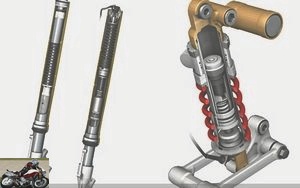
Dynamic Traction Control (DTC)
In "Slick" mode, traction control can be adapted to changing grip conditions, via the "Slick + DTC" toggle button housed on the left handlebar stalk. This gives the pilot the opportunity to react to changes in the surrounding conditions, such as ambient and asphalt temperatures, to the grip of the tires which changes over time, as well as to the condition of the road surface..
The adjustment range goes from –7 to +7 through 0. The value 0 corresponds to the adjustment of the RR in “Sport” mode, while –7 is equivalent to a significant reduction in control interventions, thus allowing much more slippage. pronounced. When set to +7, the DTC becomes more intrusive.
Dynamic Suspension Management (DDC – Dynamic Damper Control)
This system allows the rebound and compression damping to be dynamically adapted to a given situation. For example during rapid changes of direction in chicanes or at faults in the road. Semi-active steering assistance system, it reacts automatically both to maneuvers such as braking, acceleration or cornering, and to the condition of the road; It adapts the damping to the given situation with electrically managed damper valves. Unlike the ESA II controlled suspension, it is not based on characteristic laws, but on maps providing the optimal calibration of the shock absorbers within a predefined range.
The basic settings of DDC Dynamic Damping Control are interconnected with "Rain", "Sport", "Race" and "Slick" modes that the rider can activate on the handlebars. The settings menu on the instrument cluster allows it to adjust the damping. As with manual tuning, it is possible to set the suspension to a softer (-7) or firmer (+7) level. The adjustment of the base of the spring (preload) is carried out by hand, using a 17 mm wrench, as for the fork.
In "Rain" and "Sport" mode, the DDC setting favors pleasant and flexible damping for optimal road use. In "Race" and "Slick" mode, on the other hand, it aims for high performance and promotes resolutely sporty driving, especially on the circuit..
Damping is adjusted in a few thousandths of a second via an electrically managed damper valve, acting on an annular slot to modulate the flow section of the damper oil. Regardless of the driving situation, the HP4 thus offers optimal damper adjustment in rebound and compression..
The DDC housing processes a multitude of information important to riding, such as travel stroke, motorcycle speed and throttle position. In addition, the DTC sensor block provides information on the incline of the motorcycle and other parameters.
The two arms of the inverted DDC fork have an identical structure. The differences inside the dip tubes and sleeves. For example, the spring preload adjustment mechanism which adjusts to 15mm (20mm on the RR) is located inside the right fork leg. The valve allowing dynamic adjustment of the damping force and its electrical connector are integrated into the shock absorber cartridge of the left fork leg. The expansion volume in the lower part of the left fork leg is subjected to higher gas pressure and absorbs the volume of oil forced by the piston rod of the shock absorber into the closed cartridge.
As standard equipment, the telescopic fork’s damping control is not separate, so rebound and compression are managed together. The HP4’s wiring harness, however, is pre-equipped for connecting a linear travel sensor to the fork. The electronics box identifies the connected sensor and then automatically adds the separate adjustment of the expansion and compression stages to the menu on the instrument cluster. This sensor is available as an accessory.
The new DDC handset is screwed to the frame via a light alloy insert, called a slide. The motorcycle comes with a 0mm insert. The two attached inserts (1.5 and 3 mm) allow the rear of the motorcycle to be raised and the geometry of the chassis to be quickly adapted to the conditions of the circuit taken and to the individual wishes of the rider. When another slider is used, the rear travel sensor must be recalibrated accordingly via the DDC settings menu. At the front, the adaptation involves tightening the triple clamp.
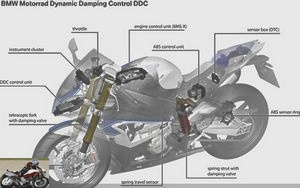
Related articles
-
Honda CBR 1000 RR Fireblade test
The era of e-Total Control A quarter of a century has seen the evolution of one of the most efficient and unique sports cars in the segment: the CBR…
-
Kawasaki Ninja 1000 SX motorcycle test
Compromise without compromise 4 cylinders of 1,043 cm3, 142 hp and 111 Nm, 235 kg, from 14,349 euros In 2010, Kawasaki presented its first Z1000SX, a…
-
Honda CBR 1000 RR Fireblade motorcycle test
20 years under the sign of total control 1992 saw the appearance of the very first CBR Fireblade, cubing 893 cm3 and has since become a sports icon. At…
-
BMW S1000RR motorcycle test in full
New generation mutant At the end of 2009, a German UFO fell in the small world of hyper sports cars: BMW upset the segment with its S 1000 RR. Unexpected…
-
Aprilia RSV4 RR & RF Factory test
Absolut Diva Ultimate evolution of hypersport from Noale’s firm A benchmark in the Superbike Championship, the Aprilia RSV4 boasts a unique engine and a…
-
Zero SR / S electric motorcycle test
Z-Force battery of 14.4 kWh, Torque 190 Nm, 229 kg, € 21,700 Quiet Watts ! It has been a few years since electric motorcycles arrived on the market, Zero…
-
Aprilia RSV4 1100 Factory motorcycle test
Veramente sensazionale V4 at 65 ° of 1.078 cm3, 217 hp and 122 Nm, 199 kg full made, 22,999 euros There are machines whose surname is almost better known…
-
The race in the lead Sports motorcycles are often mechanical legends whose rarefaction of renewal increases their exceptional character. Obvious for the…
-
Germanic M-aestria 4 cylinders in line, 999 cm3, 212 hp, 113 Nm, 192 kg full made, 33,270 euros M … the acronym which signs the finest BMW achievements…
-
Seductive bestial of 173 horses … in full version The aggressiveness was hardly, far from it, the prerogative of the German manufacturer … before…